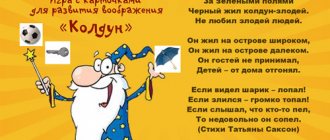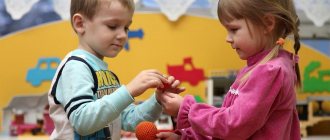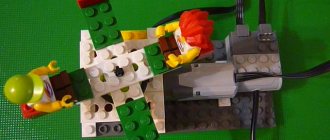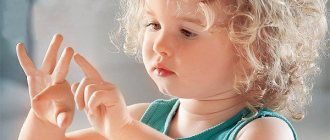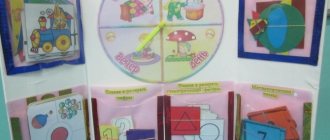Goals and objectives of board and printed games
A type of primary activity of preschool children, aimed at an analytical approach to solving a game situation, presented in the form of a visual aid, is called a printed board game.
Such games include:
- mosaics;
- didactic games in pictures (for example, a set of objects for the game “The Third Wheel”);
- folding cubes (in which the overall image is folded by turning over the faces of each cube);
- puzzles;
- lotto;
- domino;
- checkers, etc.
The goals of introducing board-printed games into the educational process are:
- consolidation or development of acquired knowledge;
- development of thinking processes, attention, memory, imagination and speech;
- training in perseverance, discipline and the ability to finish a job;
- fostering compliance, a tolerant attitude towards partners, and the ability to cooperate.
To achieve these goals, it is necessary to systematically solve the following tasks:
- consolidate knowledge about objects, their purpose, species differences;
- teach preschoolers to generalize objects according to essential features and identify relationships between them, as well as to compose parts into a whole;
- identify children’s interests (for example, compiling collective pictures from mosaic parts, putting together puzzles on a particular topic, etc.);
- develop the ability to play in small groups (children play in pairs, in threes, but if there are many participants in the group, it becomes difficult for them to decide on their role in the team - showdowns and quarrels begin);
- develop the skill of choosing play partners (by temperament, mood, etc., and not just by appearance);
- methodically competently build a system of interaction between children (the teacher plays the role of guiding the game process, but not the leader);
- encourage children's independence.
Progress of the game
pictures on the table , children must collect them and explain why the border guard needs this item (helmet, gun, machine gun, pistol, binoculars, bowler hat, mug, etc.)
— What is shown in your picture ? (binoculars)
— Why does the border guard need this item? (watch the border)
etc.
"The city is."
Didactic task: Systematize children's knowledge about the city as a populated area with roads, houses, social buildings, etc.
Game rules: Take only one silhouette. Act on a signal. the children's answers and help them if necessary.
Game action: Selecting a silhouette. Dialogue between teacher and children .
Didactic material: magnetic board, silhouettes of roads, houses, cars, etc.
Visual material
Visualization is one of the main principles of gaming activities and the entire educational process in kindergarten. To carry out this work, certain visual aids are required. In other words, to create a picture from a mosaic, you need its diagram, and to create a picture from a puzzle, you need a solid image as a hint.
Games based on visual perception of information are associated with games such as:
- plot or symbolic pictures, images for the development of speech, mastering the basics of mathematics, familiarization with the world of things and nature, etc.;
- puzzles (including three-dimensional ones);
- lotto and domino sets;
- cubes;
- mosaics;
- “Adventure games” with chips and dice.
In order not to lead to hysterics, immediately stipulate that each child will have his own set of props, for example, a separate puzzle. If kids see such toys for the first time, then you need to give them time to get to know each other, and only then move on to playing. Please note that in younger groups, the folding process itself is important for children, so the picture should be the same - then there will be no tears. In older groups, you can give each student their own puzzle, and the pictures will be different. If time allows, then include in the game the stage of exchanging details: this way the kids will be able to put together different stories, and training motor skills and thinking will be more productive.
Another important point. For some games, for example, lotto, dominoes, it is assumed that there is one set for a certain number of players. But there may be more children in the group. In this case, you should take care of purchasing not one, but two sets. And divide the playing chips (or other game materials) equally.
Table: features of choosing games for children of different ages
| Age /group | Features of development | Games | Examples | Time | Notes |
| 2–2.5 (first minor) | Games must have plot pictures |
|
| Up to 5 minutes | If the regime allows (there is time before bed or before meals), then it would be good to change this activity to a more active one |
| 3–4 (second youngest) | Interest in games in pairs |
|
| 7 minutes | The work is aimed at speech development |
| 4–5 years (average) | Work in small groups (3–4 people) |
|
| 7–8 minutes | |
| 5–6 years old (older) | Conscious participation in team games |
|
| 10 minutes | Combining physical activity of an adult and a child |
| 6–7 years (preparatory) | Intolerance towards adult help |
|
| 10–12 minutes | Children learn to comment on their actions with high independence in completing tasks |
Card index of board-printed games in kindergarten
The card index of ready-made games is grouped according to the age of the children, which is reflected both in the tasks being solved and in the content of the game.
First junior group
For this category of kids, it is appropriate to use materials that involve putting together whole pictures from individual pieces, usually an even number (from 4 to 6). In addition, you need to use mosaics that develop fine motor skills. This type of game involves folding pictures based on a pattern.
Another important nuance regarding the method of playing the game: at first, the kids complete the task themselves with the help of an adult, then without an assistant. The last, most difficult stage of the work can be folding pictures at speed, but without a competitive moment. Paired or group games are not introduced in classes; each participant must have their own set of materials to avoid the possibility of quarrels.
“Who hid in the cubes?”
Tasks:
- introduce children to the main representatives of domestic and wild animals; develop the skill of combining elements into a single plot;
- increase cognitive motivation.
Instructions:
1. “Guys, here is a picture of an animal, but it has split into 4 parts. Consider them." Note: if this is not the first time that children have performed such a task, then you can ask them to name those parts of the body that are on the faces of the cube.
2. “Now try to fold the little animal. To do this, find a cube with a head on it and place the rest on it.”
3. Together with the children, we name the resulting animal.
Mosaic, geometric shapes
Tasks:
- consolidate knowledge of basic geometric shapes (square, circle, triangle, oval);
- help kids learn to correlate a verbal image with an image;
- develop attention and memory;
- cultivate persistence in work.
Instructions:
1. Children receive a set of geometric shapes and a base (cardboard or wood, plastic) with indentations. “Guys, name the shapes corresponding to each indentation.”
2. “Now find among your figures those that fit the shape on the base.”
Second junior group
In addition to the methodological subtleties characteristic of the first junior group, an element of team play is added.
Dominoes "Animals"
Tasks:
- consolidate children's knowledge about domestic or wild animals;
- teach to correlate the visual and auditory images of a word;
- develop attention, speech;
- develop the ability to work in a team.
Instructions:
1. Each child receives 4–5 dominoes.
2. The teacher places the first bone.
3. Kids take turns putting matching pictures of animals.
At this stage, you can assign tasks to complete in pairs.
“The Third Wheel” (theme “Dishes”)
Tasks:
- teach children to separate an extra element from those united by some characteristic;
- develop logical thinking;
- cultivate patience.
Instructions:
1. Children receive 3 pictures.
2. “Guys, look at the pictures, name the objects.”
3. “Which element and why is extra?”
Middle group
When working with this age group, the emphasis is on speech development. Therefore, all games involve detailed commentary along the way.
"What season?"
Tasks:
- consolidate children’s knowledge about the seasons and their defining features;
- develop speech and logical thinking.
Instructions:
1. The teacher gives the children 2-3 pictures depicting characteristic signs of a particular time of year (for example, children are making a snowman, trees are covered in snow, a janitor is clearing paths).
2. “Guys, don’t show your pictures to anyone. We will guess what is depicted on them.” Turning to the child, he asks him to describe what is drawn on the first card.
3. Whoever guessed correctly names the time of year.
4. The one who made the guess shows the picture to make sure that the season is guessed correctly.
"Paired pictures"
Tasks:
- train to find similarities and differences between two pictures, learn to select the same ones;
- develop the ability to follow the rules of the game.
Instructions:
1. The teacher takes 2 pictures that depict the same objects. He asks what it is and also gives additional information (they are the same).
2. Then the teacher gives the children 6 cards each and asks them to find pairs.
To make it more difficult, you can arrange the pictures in a column, give the kids a set of 3-4 cards and ask them to find pairs for their children in a common column.
Senior group
A distinctive feature of working with children of this age is that children need to be taught to compare objects according to a unifying characteristic.
"Numbers"
Tasks:
- teach ordinal counting from 1 to 10;
- learn to compare the number with the number of objects in the picture;
- train voluntary attention, cultivate patience.
Instructions:
1. Children receive 2-3 central blocks with images of numbers and 10 figured cards with images of objects ranging from 1 to 10.
2. Kids must connect the central block with matching shapes to make a solid circle.
Preparatory group
For this age category, it is important to choose games where the plot requires commentary.
“What does the doctor need?”
Tasks:
- generalize children’s knowledge about professions and expand knowledge about the purpose of certain work-related items;
- develop fine motor skills, speech, and the ability to logically construct statements.
Instructions:
1. There are cut pictures on the table (for example, tools).
2. Children collect entire episodes.
3. Explain the purpose of the images obtained.
Progress of the game
Children choose silhouettes on the table, lay them out on a magnetic board and answer questions.
- This is the city. (roads)
And Matryoshka asks the children questions:
— Why do we need roads in the city? (people and cars move along the roads)
- This is the city. (Houses)
— Why are houses needed in the city? (people live in houses)
- This is the city. (the shops)
— Why do we need shops in the city? (people buy food and things in stores)
- This is the city. (hospitals and clinics)
— Why do we need hospitals in the city? (people are treated in hospitals and clinics)
etc.
Matryoshka looks at houses:
- How different are the houses, and who lives in these houses? ( children’s are discussed and lead to the fact that children and their families live in houses)
“Collect the picture and guess ”
Didactic task: Systematize children’s knowledge about the heroes of N.’s story . Nosov "Dunno and his friends!"
.
Game rules: Take only one envelope and assemble the picture at the teacher’s signal. Whoever collects the picture names it.
Game action: Finding parts, putting together the whole picture , guessing.
Didactic material: envelopes with cut pictures . The hero of N. Nosov’s story “Dunno and His Friends!”
